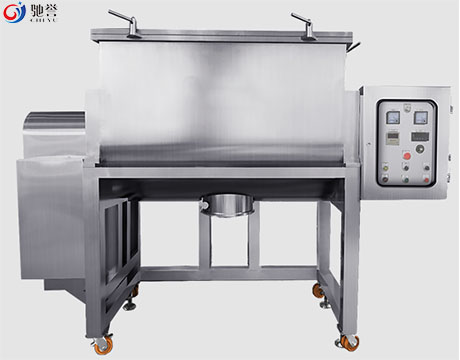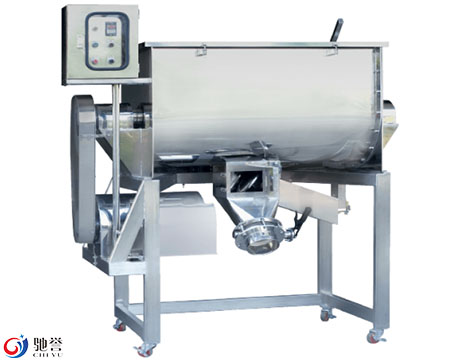Copyright © 2021 Zhangjiagang ChiYu Automation Equipment Co., Ltd. by iwonder.cn All rights reserved. Site Map
In the realm of industrial production, powder mixing is a fundamental yet complex process that influences the quality, consistency, and efficiency of a wide variety of products — from pharmaceuticals and food ingredients to chemicals and construction materials. Traditional methods, while still in use, are increasingly being replaced or augmented by automated systems due to the challenges that arise with manual or semi-automated mixing. Mixer automatic technologies have emerged as a solution to address these challenges by offering precision, consistency, and efficiency at scale.
This article delves into the primary challenges of industrial powder mixing and how automated mixers are transforming this critical manufacturing operation.
Mixing powders may seem straightforward, but the process is fraught with variables that can lead to inconsistent product quality, process inefficiencies, and even safety hazards. Industrial powders often vary in particle size, shape, density, flow characteristics, and moisture content. These differences can result in segregation during or after mixing, leading to non-uniform product batches.
In industries such as pharmaceuticals or food processing, even slight inconsistencies can affect the efficacy or safety of the final product. Thus, achieving and maintaining homogeneity is not just a matter of quality — it's a regulatory necessity.

Before understanding how mixer automation solves these issues, it’s important to identify the most common challenges encountered in the industry:
During or after mixing, particles can separate based on differences in size or density. This leads to uneven distribution of active ingredients, which is unacceptable in applications like drug manufacturing.
Manual or poorly controlled mixing processes can result in overmixing, which may alter the physical or chemical properties of the powders, or undermixing, which leaves the mix incomplete and inconsistent.
Frequent cleaning is required between batches, especially when switching materials. Manual cleaning can be time-consuming and ineffective, posing the risk of cross-contamination.
Scaling up from laboratory to industrial scale often leads to mixing inefficiencies. Maintaining product quality while increasing production volume is a constant challenge.
Older, non-automated systems may use excessive energy or run longer than necessary due to lack of precise control.
Mixer automatic systems are designed to address all of the above challenges through integrated technology and smart design. These systems are equipped with programmable logic controllers (PLCs), sensors, actuators, and software that allow precise control of every parameter of the mixing process.
Here’s how they solve the key industrial powder mixing challenges:
Automated mixers can be programmed to follow exact mixing cycles, adjust speed dynamically, and monitor torque to ensure that the mixture reaches the desired level of homogeneity. Advanced algorithms and real-time data feedback help operators achieve optimal blending without over-processing the material.
The result is a consistent and repeatable product, no matter the batch size or material composition.
Many automatic mixers include features like variable-speed agitation, baffles, and customized container geometries to minimize segregation during and after mixing. Some systems also employ tumble mixing or 3D motion technologies to provide uniform movement of all particles.
Moreover, the ability to control discharge speeds and directions reduces the likelihood of material separation during packaging.
One of the standout features of mixer automatic systems is the Clean-in-Place (CIP) functionality. This allows for automated washing and drying cycles within the mixing chamber, drastically reducing cleaning time and minimizing human exposure to potentially hazardous powders.
As a result, facilities can switch between batches more rapidly, maintaining hygiene and productivity without compromising on safety.
With built-in sensors and software integrations, automated mixers can monitor temperature, moisture content, and even chemical reactivity in real-time. Some systems offer Near-Infrared (NIR) sensors or Raman spectroscopy for in-process quality checks.
This level of process control ensures that mixing complies with industry regulations and internal quality benchmarks, reducing the likelihood of costly rework or product recall.
Mixer automatic systems are not only precise but also efficient. By minimizing unnecessary operation time and optimizing energy consumption, these systems help manufacturers reduce their carbon footprint.
In many cases, these systems pay for themselves within a few years by cutting energy costs, improving throughput, and minimizing material waste.
Today’s automated mixers are built with scalability and digital integration in mind. They can be easily incorporated into a fully digital manufacturing ecosystem, allowing data from the mixing process to be shared across departments — from quality control to inventory management.
Through IoT connectivity, manufacturers gain real-time visibility of operations, predictive maintenance alerts, and data analytics that can drive continual improvement.
Mixer automatic technology is now widely adopted across multiple sectors:
Pharmaceuticals: Ensures dosage uniformity and compliance with GMP standards.
Food and Beverage: Achieves consistent taste and texture while maintaining hygiene.
Chemical Industry: Handles hazardous or reactive powders with minimal risk.
Cosmetics: Blends sensitive ingredients without damaging texture or color.
Construction Materials: Mixes additives into cement or plaster to exact ratios.
Each industry has unique requirements, and mixer automation can be tailored to meet these specialized needs.

Before investing in an automated mixer, manufacturers should evaluate:
Type of material and required mix quality
Batch size and production capacity
Cleaning and maintenance requirements
Space and infrastructure compatibility
Compliance with industry-specific standards (e.g., FDA, ATEX)
Consulting with experienced equipment providers can help identify the right solution tailored to operational goals and constraints.
Looking ahead, the integration of artificial intelligence and machine learning into mixer automatic systems is set to revolutionize the field even further. Future systems may predict optimal mixing times based on material properties, self-adjust to correct deviations in real time, and suggest maintenance schedules to prevent unplanned downtime.
These smart features will make powder mixing not only more efficient but more adaptive — a key advantage in today’s fast-changing industrial landscape.
Powder mixing is a critical step in many industrial production lines, and the cost of getting it wrong can be high. From inconsistent product quality to safety risks and wasted resources, the traditional manual approach simply doesn’t meet the demands of modern manufacturing.
Mixer automatic systems provide a comprehensive solution by improving precision, reducing labor, and ensuring consistent product quality. As more industries adopt automation to stay competitive and compliant, automated mixers are fast becoming a standard rather than a luxury.
If your business faces challenges in powder blending or is looking to scale operations, it’s time to consider how mixer automation can streamline your process and elevate your production standards.